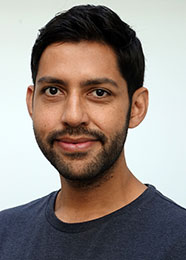Research interests
Dr Andrew Das completed his combined medical and postgraduate studies (MBChB/PhD) at the University of Otago. For the PhD component of his degree he worked with Professors' Tony Kettle and Christine Winterbourn in the area of free radical biochemistry. He also developed expertise in mass spectrometry (peptide, protein and small molecule analysis), experimental biochemistry (free radical trapping, protein purification, enzyme assays and protein electrophoresis) and experience with cell and molecular biology (cell culture, transfection, PCR and cloning). During this time, he became very interested in epigenetic mechanisms that play a role in development and cancer.
Together with Professor Margreet Vissers, he is investigating the potential role of ascorbate as an epigenetic therapeutic in specific subtypes of acute myeloid leukaemia. The long-term goal is to identify epigenetic subtypes of AML that may respond to treatment. A second project with Professor Hampton is investigating whether reactive oxidant species produced by immune cells can regulate affect the epigenetic identity of neighbouring cells.
In 2018, Dr Das was awarded a NZ Society of Oncology Fellowship (Roche Translational Cancer Research Fellowship) to enable developing the epigenetic and bioinformatic expertise required for these projects. Dr Das was also recently awarded a John Gavin Postdoctoral Research Fellowship by the Cancer Research Trust.
What is epigenetics?
Each of us begins life as a single cell, a fertilised egg. We then embark on a journey that culminates in our birth. Over these nine months or so, an incredible process takes place, the development of all the various cells and organs that make up our body. Because every cell has the same DNA code, extra markings are required to tell each cell which part of the DNA code they should be using. In other words, these epigenetic markings help cells remember their identity. Epigenetic markings can be on the DNA itself, or on the proteins that DNA is wrapped tightly around to package it inside our cells. A similar process occurs on a daily basis, where your body produces billions of blood cells across a wide range of cell types. These cells all come from haematopoietic stem cells located in the bone marrow, with each type requiring different epigenetic markings to guide their development.
What does this have to do with leukaemia?
When cells acquire mutations in DNA that affect this process, they become dysfunctional and potentially cancerous. This is in fact what we see with AML. Interestingly, these mutations appear earlier in the course of the disease and drive the development of AML. Because epigenetic markings can be written or erased, the effects are potentially reversible. A prime example is mutations that affect the activity of the enzyme TET2. TET2 is involved in erasing a marking called methylation, and requires ascorbate for optimal activity. Furthermore, supplying additional ascorbate can increase the activity of TET2. These observations have led to the postulation that patients with decreased TET2 activity could benefit from treatment with ascorbate. The team are currently using a number of different approaches to investigate this hypothesis. So far, this work led to a first-in-human demonstration that ascorbate might provide benefit as an adjunct treatment where mutations affect the activity of the DNA demethylase TET2. Although clinical trials explicitly designed to address this possibility are required, the insights provided by the case study will assist in their design.
In the media
Dr Andrew Das was interviewed on Radio New Zealand by Kim Hill in September 2018 about his research into the role of epigenetics in cancer.
Publications
Smith-Díaz, C. C., Magon, N. J., McKenzie, J. L., Hampton, M. B., Vissers, M. C. M., & Das, A. B. (2021). Ascorbate inhibits proliferation and promotes myeloid differentiation in TP53-mutant leukemia. Frontiers in Oncology, 11, 709543. doi: 10.3389/fonc.2021.709543 Journal - Research Article
Das, A. B., Seddon, A. R., O'Connor, K. M., & Hampton, M. B. (2021). Regulation of the epigenetic landscape by immune cell oxidants. Free Radical Biology & Medicine, 170, 131-149. doi: 10.1016/j.freeradbiomed.2020.12.453 Journal - Research Article
Das, A. B., Smith-Diaz, C. C., & Vissers, M. C. M. (2021). Emerging epigenetic therapeutics for myeloid leukemia: Modulating demethylase activity with ascorbate. Haematologica, 106(1), 14-25. doi: 10.3324/haematol.2020.259283 Journal - Research Other
Vissers, M. C. M., & Das, A. B. (2018). Potential mechanisms of action for vitamin C in cancer: Reviewing the evidence. Frontiers in Physiology, 9, 809. doi: 10.3389/fphys.2018.00809 Journal - Research Other
Das, A. B., Kakadia, P. M., Wojcik, D., Pemberton, L., Browett, P. J., Bohlander, S. K., & Vissers, M. C. M. (2019). Clinical remission following ascorbate treatment in a case of acute myeloid leukemia with mutations in TET2 and WT1. Blood Cancer Journal, 9, 82. doi: 10.1038/s41408-019-0242-4 Journal - Research Other


